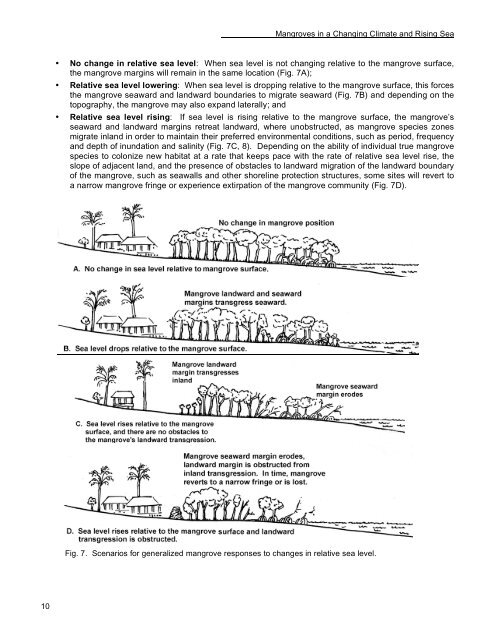Pacific Island Mangroves in a Changing Climate and Rising Sea
Pacific Island Mangroves in a Changing Climate and Rising Sea
Pacific Island Mangroves in a Changing Climate and Rising Sea
Create successful ePaper yourself
Turn your PDF publications into a flip-book with our unique Google optimized e-Paper software.
10<br />
<strong>Mangroves</strong> <strong>in</strong> a Chang<strong>in</strong>g <strong>Climate</strong> <strong>and</strong> Ris<strong>in</strong>g <strong>Sea</strong><br />
• No change <strong>in</strong> relative sea level: When sea level is not chang<strong>in</strong>g relative to the mangrove surface,<br />
the mangrove marg<strong>in</strong>s will rema<strong>in</strong> <strong>in</strong> the same location (Fig. 7A);<br />
• Relative sea level lower<strong>in</strong>g: When sea level is dropp<strong>in</strong>g relative to the mangrove surface, this forces<br />
the mangrove seaward <strong>and</strong> l<strong>and</strong>ward boundaries to migrate seaward (Fig. 7B) <strong>and</strong> depend<strong>in</strong>g on the<br />
topography, the mangrove may also exp<strong>and</strong> laterally; <strong>and</strong><br />
• Relative sea level ris<strong>in</strong>g: If sea level is ris<strong>in</strong>g relative to the mangrove surface, the mangrove’s<br />
seaward <strong>and</strong> l<strong>and</strong>ward marg<strong>in</strong>s retreat l<strong>and</strong>ward, where unobstructed, as mangrove species zones<br />
migrate <strong>in</strong>l<strong>and</strong> <strong>in</strong> order to ma<strong>in</strong>ta<strong>in</strong> their preferred environmental conditions, such as period, frequency<br />
<strong>and</strong> depth of <strong>in</strong>undation <strong>and</strong> sal<strong>in</strong>ity (Fig. 7C, 8). Depend<strong>in</strong>g on the ability of <strong>in</strong>dividual true mangrove<br />
species to colonize new habitat at a rate that keeps pace with the rate of relative sea level rise, the<br />
slope of adjacent l<strong>and</strong>, <strong>and</strong> the presence of obstacles to l<strong>and</strong>ward migration of the l<strong>and</strong>ward boundary<br />
of the mangrove, such as seawalls <strong>and</strong> other shorel<strong>in</strong>e protection structures, some sites will revert to<br />
a narrow mangrove fr<strong>in</strong>ge or experience extirpation of the mangrove community (Fig. 7D).<br />
Fig. 7. Scenarios for generalized mangrove responses to changes <strong>in</strong> relative sea level.

















